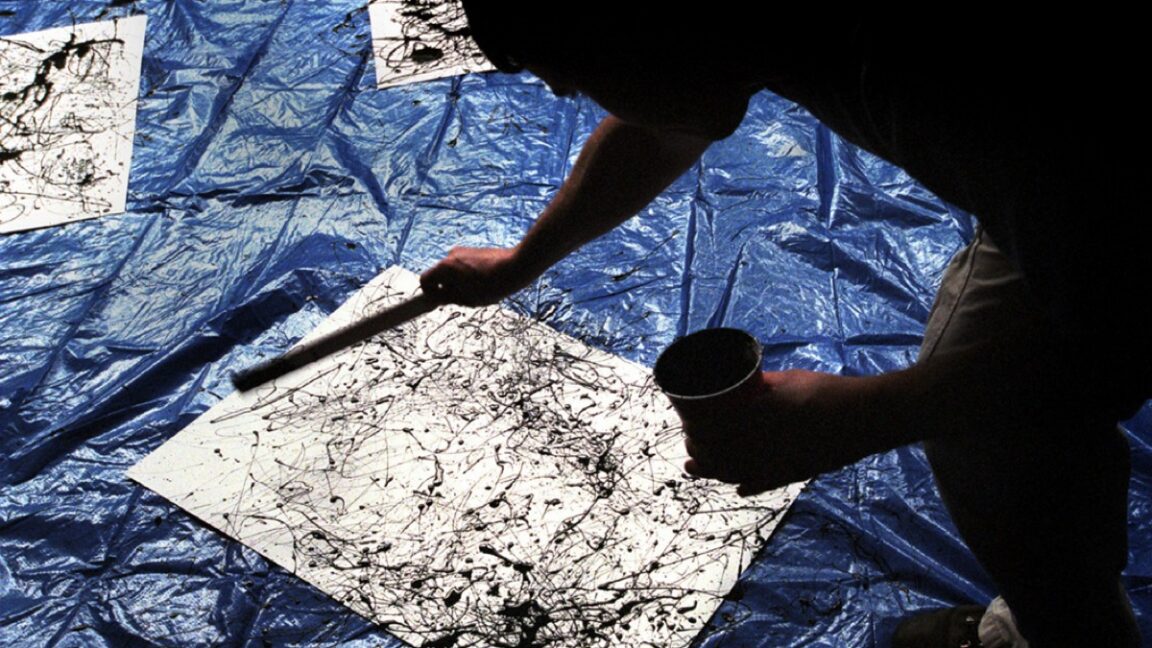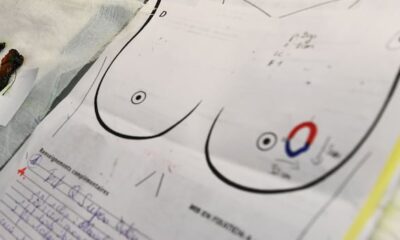Science
Children’s Paintings Mirror Pollock’s Style More Than Adults’

Recent research has revealed that the drip paintings created by young children bear a closer resemblance to the works of renowned artist Jackson Pollock than those produced by adults. This surprising finding arises from a study published in Frontiers in Physics, which examines the fractal characteristics of splatter paintings made by individuals of different age groups. The work suggests that children’s unique physicality may influence their artistic output, aligning more closely with Pollock’s distinctive style.
The study, co-authored by Richard Taylor, a physicist at the University of Oregon, builds on his earlier research, which first identified fractal patterns in Pollock’s drip paintings in 2001. Taylor’s findings ignited debate among art historians and physicists, particularly regarding the validity of using fractal analysis as a means of authenticating Pollock’s work. In a 2006 critique published in Nature, physicists Katherine Jones-Smith and Harsh Mathur argued that Taylor’s methods lacked sufficient scale to be deemed fractal, even producing their own version of a fractal painting in a matter of minutes.
Despite early criticism, Taylor’s research gained traction following a 2015 machine-learning study that achieved a remarkable 93 percent accuracy in distinguishing genuine Pollock paintings from forgeries. By 2024, Taylor reported even greater success, with an accuracy rate of 99 percent. His ongoing fascination with the intersection of art and science has led him to explore how physical characteristics influence artistic expression, particularly in Pollock’s work.
The Influence of Physiology on Artistry
Pollock’s technique of pouring paint onto flat canvases involved a significant physical element. Contrary to the image of a graceful artist, Taylor describes Pollock as “notoriously clumsy,” a quality that may have contributed to his unique artistic style. Observing Pollock’s work process, Taylor noted that the artist often leaned over his canvases, which may have triggered a fractal fluency effect, enhancing the chaotic beauty of his paintings.
Taylor’s curiosity about the correlation between physicality and artistry led him to consider how balance affects the creative process. He drew parallels with other renowned artists, such as Claude Monet and Vincent van Gogh, whose physical challenges shaped their artistic outputs. “Great art can come out of something that, on a day-to-day basis, would be a limit,” he reflected.
To further investigate this hypothesis, Taylor organized “Dripfests,” events where both children and adults could create Pollock-like artworks. Initially delayed by life changes, the concept was revived, leading to a study involving 18 children aged four to six and 34 adults aged 18 to 25. The significant age gap between the two groups allowed for an examination of how different stages of biomechanical balance development affect artistic expression.
Analyzing Paintings Through Fractals
The study’s authors not only assessed the fractal dimensions of the paintings but also examined a concept known as “lacunarity,” which looks at the variations in gaps between paint clusters. The results revealed that adult paintings exhibited higher paint densities and more varied trajectories compared to those created by children. In contrast, the children’s work demonstrated smaller fine-scale patterns with greater gaps between paint clusters, resulting in simpler trajectories that changed direction less frequently.
Taylor explained, “They both have coarse-scale motions, but the adults have lots of fine-scale structure.” This difference suggests that the mechanisms of balance and movement during painting can influence the complexity of the resulting artwork.
The research also allowed for comparisons with Pollock’s painting Number 14 and Max Ernst’s Young Man Intrigued by the Flight of a Non-Euclidean Fly. The analysis indicated that Ernst’s controlled, pendulum-based technique produced fractal dimensions similar to those of the children’s paintings, signifying a departure from the natural rhythms seen in Pollock’s works.
While this study highlights the artistic capabilities of children and their resonance with Pollock’s style, the authors acknowledge that they did not directly measure the subjects’ balance while painting. Future Dripfests will incorporate motion sensors to analyze the relationship between the artists’ movements and their painting patterns.
As research continues, Taylor aims to expand his analysis of lacunarity across Pollock’s oeuvre and other artists who utilize drip or pouring techniques. This ongoing exploration into the physics of art not only sheds light on the creative process but also redefines our understanding of artistic expression through the lens of science.
-

 Politics2 weeks ago
Politics2 weeks agoSecwepemc First Nation Seeks Aboriginal Title Over Kamloops Area
-

 World4 months ago
World4 months agoScientists Unearth Ancient Antarctic Ice to Unlock Climate Secrets
-

 Entertainment4 months ago
Entertainment4 months agoTrump and McCormick to Announce $70 Billion Energy Investments
-

 Lifestyle4 months ago
Lifestyle4 months agoTransLink Launches Food Truck Program to Boost Revenue in Vancouver
-

 Science4 months ago
Science4 months agoFour Astronauts Return to Earth After International Space Station Mission
-

 Technology3 months ago
Technology3 months agoApple Notes Enhances Functionality with Markdown Support in macOS 26
-

 Top Stories1 month ago
Top Stories1 month agoUrgent Update: Fatal Crash on Highway 99 Claims Life of Pitt Meadows Man
-

 Sports4 months ago
Sports4 months agoSearch Underway for Missing Hunter Amid Hokkaido Bear Emergency
-

 Politics3 months ago
Politics3 months agoUkrainian Tennis Star Elina Svitolina Faces Death Threats Online
-

 Politics4 months ago
Politics4 months agoCarney Engages First Nations Leaders at Development Law Summit
-

 Technology4 months ago
Technology4 months agoFrosthaven Launches Early Access on July 31, 2025
-

 Lifestyle2 months ago
Lifestyle2 months agoManitoba’s Burger Champion Shines Again Amid Dining Innovations





















